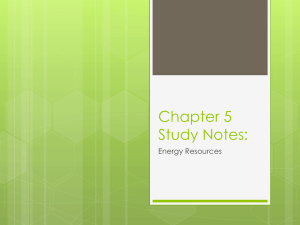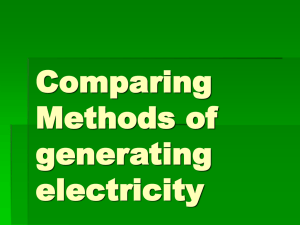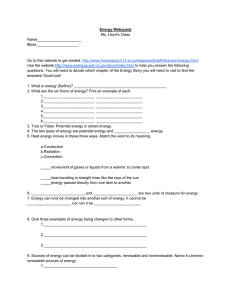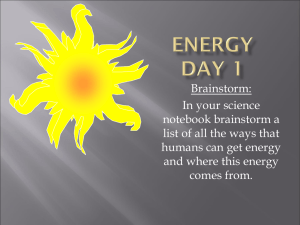Nonrenewable Energy Section 1
advertisement
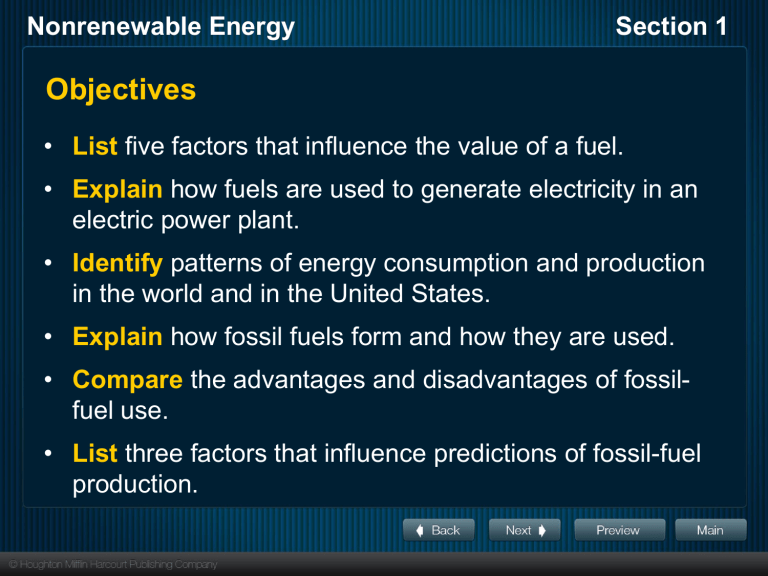
Nonrenewable Energy Section 1 Objectives • List five factors that influence the value of a fuel. • Explain how fuels are used to generate electricity in an electric power plant. • Identify patterns of energy consumption and production in the world and in the United States. • Explain how fossil fuels form and how they are used. • Compare the advantages and disadvantages of fossilfuel use. • List three factors that influence predictions of fossil-fuel production. Nonrenewable Energy Section 1 Energy Resources and Fossil Fuels • A fossil fuel is a nonrenewable energy resource formed from the remains of organisms that lived long ago; examples include oil, coal, and natural gas. • Most of the energy we use comes from this group of natural resources called fossil fuels. • We use fossil fuels to run cars, ships, planes, and factories and to produce electricity. Nonrenewable Energy Section 1 Energy Resources and Fossil Fuels • • Fossil fuels are central to life in modern societies, but there are two main problems with fossil fuels. • The supply of fossil fuels is limited. • Obtaining and using them has environmental consequences. In the 21st century, societies will continue to explore alternatives to fossil fuels but will also focus o developing more-efficient ways to use these fuels. Nonrenewable Energy Section 1 Fuels for Different Uses • Fuel is used for four main purposes: • Transportation • Manufacturing • Heating and cooling buildings • Generating electricity to run machines and appliances • Different fuels are used for different purposes. • The suitability of a fuel for each application depends on the fuel’s energy content, cost, availability, safety, and byproducts. Nonrenewable Energy Section 1 Electricity-Power on Demand • Because electricity is more convenient to use, the energy in fuel is often converted before used. • Electricity can be transported quickly across great distances. • This makes it a good source of power for computers, light switches, and more. • Two disadvantages of electricity are that it is difficult to store and other energy sources have to be used to generate it. Nonrenewable Energy Section 1 How Is Electricity Generated? • An electric generator is a device that converts mechanical energy into electrical energy. • Generators produce electrical energy by moving an electrically conductive material within a magnetic field. • Most commercial electric generators convert the movement of a turbine into electrical energy. A turbine is a wheel that changes the force of a moving gas or a liquid into energy that can do work. • The turbine spins a generator to produce electricity. Nonrenewable Energy Section 1 How Is Electricity Generated? • The turbine spins because of the steam released from boiling water. • The water is heated using a coal-fired or gas-fired plant, or is heated from the fission of uranium in nuclear plants. Nonrenewable Energy How Is Electricity Generated Section 1 Nonrenewable Energy Section 1 World Energy Use • Everything you do, from the food you eat to the clothes you wear requires energy. • There are dramatic differences in fuel use and efficiency throughout the world. • People in developed societies use more energy than people in developing countries do. • And within developed societies, there are differences in energy consumption. Nonrenewable Energy Section 1 World Energy Use • The difference in energy use among developed countries depends on how energy is generated and used in those countries. Nonrenewable Energy Energy Use in the United States • The United States uses more energy per person than most other countries do. • The U.S. uses more than 25% of its energy to transport goods and people. Section 1 Nonrenewable Energy Section 1 Energy Use in the United States • Other countries, such as Japan and Switzerland, depend on extensive rail systems and are smaller, compact countries • Residents of the United States and Canada enjoy some of the lowest gasoline taxes in the world. There is little incentive to conserve gasoline when its cost is so low. • Countries with limited fossil-fuel resources supplement a greater percentage of their energy needs with other energy sources, such as hydroelectric or nuclear. Nonrenewable Energy Section 1 How Fossil-Fuel Deposits Form • Fossil fuel deposits are not distributed evenly. • There is an abundance of oil in Texas and Alaska, but very little in Maine. • The eastern United States produces more coal than other areas. • The reason for this difference lies in the geologic history of the areas. Nonrenewable Energy Section 1 Oil and Gas Deposits in the United States Nonrenewable Energy Section 1 Coal Formation • Coal forms from the remains of plants that lived in swamps hundreds of millions of years ago. • As ocean levels rose and fell, swamps were repeatedly covered with sediment. • Layers of sediment compressed the plant remains, and heat and pressure within Earth’s crust caused coal to form. • Much of the coal in the United States formed about 300 to 250 million years ago. Deposits in western states, however, formed between 100 and 40 million years ago. Nonrenewable Energy Section 1 Oil and Natural Gas Formation • Oil and natural gas result from the decay of tiny marine organisms that accumulated on the bottom of the ocean millions of years ago. • These remains were buried by sediments and then heated until they became complex energy-rich carbon molecules. • These molecules, over time, migrated into the porous rock formations that now contain them. Nonrenewable Energy Section 1 Coal • Most of the world’s fossil-fuel reserves are made up of coal. • Coal is relatively inexpensive and it needs little refining after being mined. • Asia and North America are particularly rich in coal deposits. Nonrenewable Energy Coal Section 1 Nonrenewable Energy Section 1 Coal • Nearly one-half the electricity generated in the United States comes from coal-fired power plants. Nonrenewable Energy Section 1 Coal Mining and the Environment • The environmental effects of coal mining vary. • Underground mining may have minimal effect on the environment at the surface, but surface coal-mining operations sometimes remove the top of an entire mountain to reach the coal deposit. • A lot of research focuses on locating the most productive, clean-burning coal deposits and finding less damaging methods of mining coal. Nonrenewable Energy Section 1 Air Pollution • The quality of coal varies. Higher-grade coals, such as bituminous coal, produce more heat and less pollution than lower-grade coal, such as lignite. • Sulfur, found in all grades of coal, can be a major source of pollution when coal is burned. • The air pollution and acid precipitation that result from burning high-sulfur coal without adequate pollution controls are serious problems in countries such as China. • However, cleaner-burning coal technology has dramatically reduced air pollution in countries such as the United States. Nonrenewable Energy Section 1 Petroleum • Petroleum is a liquid mixture of complex hydrocarbon compounds that is used widely as a fuel source. • Petroleum, also known as crude oil. • Anything that is made from crude oil, such as fuels, chemicals, and plastics, is called a petroleum product. Nonrenewable Energy Section 1 Locating Oil Deposits • Oil is found in and around major geologic features, such as folds, faults, and salt domes, that tend to trap oil as it moves in the Earth’s crust. • Most of the world’s oil reserves are in the Middle East. Large deposits also exist in the United States, Venezuela, the North Sea, Siberia, and Nigeria. • Geologists use many different methods to locate the rock formations that could contain oil. Nonrenewable Energy Section 1 Locating Oil Deposits • When geologists have gathered all of the data that they can from the Earth’s surface, exploration wells are drilled to determine the volume and availability of the oil deposit. • If oil can be extracted at a profitable rate, wells are drilled and oil is pumped or flows to the surface. • After petroleum is removed from a well, it is transported to a refinery to be converted into fuels and other petroleum products. Nonrenewable Energy Section 1 The Environmental Effects of Using Oil • Petroleum fuel releases pollutants when burned. • These pollutants contribute to smog and cause health problems. • Many scientists think that the carbon dioxide released from burning petroleum fuels contributes to climate change. Nonrenewable Energy Section 1 The Environmental Effects of Using Oil • Oil spills are another potential environmental problem of oil use. • While oil spills are dramatic, much more oil pollution comes from everyday sources, like leaking cars. Nonrenewable Energy Section 1 The Environmental Effects of Using Oil • Emissions regulations and technologies have helped reduce the air pollution in many areas. • Drilling in deep water or very cold ecosystems is increasing. Stopping leaks in deep water is difficult, and cold water hinders clean-up efforts in the event of a spill. • Unfortunately, measures to reduce everyday contamination of our waterways from oil lag far behind the efforts to prevent large spills. Nonrenewable Energy Section 1 Natural Gas • About 20% of the world’s nonrenewable energy comes from natural gas. • Natural gas, or methane (CH4), produces fewer pollutants than other fossil fuels when burned. • Vehicles that run on natural gas require fewer pollution controls. • Electric power plants can also use this clean-burning fuel. Nonrenewable Energy Section 1 Fossil Fuels and the Future • Fossil fuels supply about 90% of the energy used in developed countries. • As the demand for energy resources increases, the cost of fossil fuels will likely increase, making other energy sources more attractive. • Planning for the energy we will use in the future is important because it takes many years for a new source of energy to make a significant contribution to our energy supply. Nonrenewable Energy Section 1 Predicting Oil Production • Many different factors must be considered when predicting oil production. • Oil reserves are oil deposits that are discovered and are in commercial production. • Oil reserves can be extracted profitably at current prices using current technologies. • Some oil deposits, such as oil sands, were once considered too difficult or not profitable to access. Such deposits are now being tapped because of improvements in technology and increases in prices. Nonrenewable Energy Section 1 Predicting Oil Production • Prediction must also take into account the changes in technology that will allow more oil to be extracted in the future. • All predictions of future oil production are guided by an important principle: the relative cost of obtaining fuels influences the amount of fossil fuels we extract from Earth. • As supplies decrease, oil may be used more selectively. • Also, we may begin to rely on other energy sources to power items like cars and power plants. Nonrenewable Energy Section 1 Future Oil Reserves • Few large oil reserves have been discovered in the past decade. • Geologists disagree about how soon oil production from fields accessible from land will peak, with predictions ranging from 2014 to after 2020. • Additional oil reserves exist under the ocean, but it is expensive to drill for oil in the deep ocean. • Global climate change is making arctic seas more accessible for drilling, but both deep and cold drilling increase risks of pollution.


